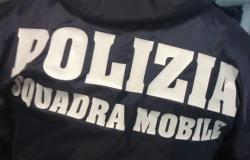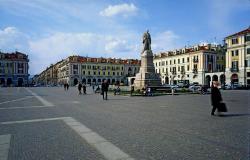A corner of Paradise sheltered from the most mass tourism and at the same time not artificial and too sophisticated, very enjoyable in June when you are still far from the madding crowd and the greenery with the ground cover flowers dominates. Here the sea is the absolute protagonist and can be found walking around the town with breathtaking views but it’s not just nature. The Mediterranean tells stories, brings back the past, updates it.
It was born like this Sardinia Archeo Festival now in its fifth edition, Imagined Mediterranean, a traveling festival between Cagliari, Sintino and the archaeological site S’Arcu is Forros. An opportunity to get in tune with the place and the Mare Bianco di Mezzo.
The first two episodes of the festival last week; today and tomorrow the appointment is in Stintino while the final stage is on 30 August 2024. After Cagliari, at the Il Ghetto Art and Culture Center (via Santa Croce 18), the protagonist is the Mut, Stintino tuna fishery museum; therefore the landing at Villagrande Strisaili at the S’Arcu is Forros archaeological site.
A popular archeology festival dedicated to the Mediterranean created with the contribution of the Sardinia Foundation and the patronage of the Municipality of Cagliari, conceived and organized by the Itzokor association which sees among the guests the archaeologists Elisabetta Garau, Flavia Frisone, Francesco Bellu, Massimo Cultraro, Valentina Porcheddu, Valentino Nizzo and Marco Minoja, the philosopher Silvano Tagliagambe, the glottologist Riccardo Ginevra, the journalist Luca Misculin and the writer Ilaria Guidantoni, the naturalist Gianni Palumbo, the historians Santiago Sabariego Sanchez and Giampaolo Salice, the teacher of Church History Anna Carfora.
The question from which it starts, what is the boundary between reality and myth in our Mediterranean takes us along stories and narratives, more or less true, which have come down to us from the past to the point of marking our present. We walk on the path of the heroes, idols, divinities who have influenced our events in this corner of the world
During the two days of the Sardinia Archeo Festival in Cagliari, thirteen male and female scholars archeologyhistory, philosophy, religion, glottology coming from the world of university, research and journalism they proposed reflections and news around the Mediterranean, the ancient cities, the myths, stories and narratives that have marked our past.
The first day opened with the photographic workshop organized by Luisa Siddi; at 3pm, in the Ghetto Walls room, the Festival will come to life with speeches by Flavia Frisonearchaeologist, Giampaolo Salicehistorical, Marco Minojaarchaeologist, who will be followed by a meeting with Luca Misculinjournalist from The postAnd Riccardo Ginevra, glottologist, authors of the podcast “The Invasion” dedicated to the diffusion of Indo-European languages and cultures, moderated by the journalist Francesca Mulas. The next day the journalist and archaeologist Valentina Porcheddu and archaeologists Massimo Cultraro and Valentino Nizzothe glottologist Riccardo Ginevrathe historian Santiago Sabariero Sanchez they addressed different points of view. So Anna Carforateacher of Church History, Gianni Palumbonaturalist and ornithologist, Francesco Bellu, journalist and archaeologist expert in cinema; while the last reflection on “The Mediterranean within us” is entrusted to the philosopher Silvano Tagliagambe. Followed by evenings of music with “Odyssey without shores. Sounds and songs from the Mediterranean” Ninfa Giannuzzi, Sandro Fresi, Luca Schiavo and Massimo Cerra will accompany the audience on a sound journey from one shore of the Mare Nostrum to the other.
Today and tomorrow appointment in memory of Marco Rendeliarchaeologist and friend of the Festival with the archaeologist Elisabetta Garau, professor from the University of Sassari will take stock of the research on the Alghero site of Sant’Imbenia, while Ilaria Guidantoni, journalist and writer, will talk about the Mediterranean languages of the pluralism of non-neighboring border languages and how words chase each other by describing the habits and customs of the salt lake which is the Mediterranean. Tomorrow another evening dedicated to history and archeology with “Gep 2024”, the European Heritage Days. Starting from 6pm Gabriella Gasperetti, archaeological official of the Superintendency of Archaeology, Fine Arts and Landscape for the Provinces of Sassari and Nuoro with Elisabetta Garrau will hold the conference “The Casteddu nuraghe of Stintino: research and valorisation perspectives”, dedicated to the archaeological complex located in the near Pozzo di San Nicola.
As mentioned, the Sardinia Archeo Festival will end in the heart of Barbagia and will open to visits with debates and screenings carried out in collaboration with Archeonova and the Festival of Archaeological Communication and Cinema of Licodia Eubea.
In Stintino the Festival takes place inside the Mut, Tonnara Museum, the heart of the country’s history, born in 2016 on the experience of a traveling exhibition of objects for Sardinia in a nautical shed in Porto Manno. The new structure is the result of recovery of the old Alpi blue fish canning factory – Fish Products Processing Company, thanks to a European project. Here are collected objects donated by the families of Stintino who worked in the factory and the exhibition is carried out through the imaginary dialogue between a tuna and Agostino Diana, last rais of the tuna factory. The audio-visual route allows the traveler to be autonomous and take a real journey on a double track, the point of view of the fish and that of the fisherman.
In the first room a touch screen tells the archeology and biology of tuna with its history since ancient times. Here there are amphorae from Cala Grande, in Asinara, in which traces of salted tuna in the form of Garum from the 4th and 5th centuries AD were found. In reality, tuna has been a symbol of prosperity since ancient times as shown by its depiction in the Genoese Cave in Levanzo, in the Sicilian islands of the Egadi and in the mosaics of Turris Libisonis, the ancient Porto Torres. Among the finds is an Askos, a tuna-shaped jar from the necropolis of San Simplicio in Olbia. In the same room aspects related to the biology of the protagonist of the museum, the Thunnus Thynnus, known as Atlantic bluefin tuna which reproduces in the Gulf of Mexico and in the Mediterranean where the traps are called ‘rushing’ because they are made with the aim of blocking the fish after spawning allowing for seasonal turnover. It happens that some tuna still has the egg sac and in that case the bottarga is divided among the fishermen as a supplement to the compensation. It is important to know that the seasonality is from May to the end of June and therefore this is an excellent time to come to Stintino to taste the tuna, the only ‘authentic’ one.
In the second room a panel summarizes the geography of the main Italian traps concentrated in Sicily. In the third room the model of the tuna catching system, a network structure called ‘island’ even if each trap has a different type of network in terms of number of chambers depending on the currents, winds and conformation of the seabed. It starts from the so-called tail which creates a barrier between the coast and the open sea because after spawning the tuna come very close to the coast and when they find the obstacle they follow it entering the first chamber and always turning to the right. Inside they are held until the day of the slaughter when the chambers are opened and the boats push the tuna into the death chamber. Then the tuna fleet made up of 13 boats forms a square, lifts the nets and with them the tuna and then proceeds to harpooning and gutting the catch on board. The same, as the videos and panels show, is taken to the tuna fishery, precisely to the scabecio for processing; while in malfarage the crew organizes the slaughter starting after Easter, a long preparation after the nets have been repaired in the winter, usually by the women.
The fourth room it leads the visitor into the rooms, on an immersive journey that is the same as the one taken by the tuna. Here there are finds and documents from the tuna fishery archive, recovered thanks to a citizen of Stintino, Prospero Maddau, who he found there when he was working on the construction site of the Hotel La Tonnara, built in the Tonnara Saline factory. Among the curiosities, the oldest document dates back to 1604. Also curious is the exhibition of models created by Isidoro Balzano, who passed away a few months ago at the age of 95, lived with a passion for visually reproducing Stintino boats, today a precious memory of boats of which the original is no longer available. On display are various work tools and the statue of the Madonna di Bonaria from the Tonnara church where Corpus Domini was celebrated every year. Along the wall runs a gallery of portraits illustrating the roles of the rigid hierarchy of the tuna fishery, including for example the figure of the Bastardiere, one of the four of the so-called Bastarda boats that closed the death chamber at the four corners. The itinerary ends with the room in which the slaughter took place, narrated by a video edited from a series of films and made in black and white so as not to disturb the visitor with the effect of the blood.
We go back down to the ground in the fifth roomOltre la tonnara, an environment that tells what happened in Stintino after the closure of the tuna fishery at the end of the Seventies, when it was proposed as a tourist destination. The sixth room presents two videos that tell, respectively, the experimental tuna fishery of the Nineties, a collaboration project between the University of Sassari and Bari and the return to the origins. In fact, Stintino was born as a settlement in 1885 when 45 families were expelled from the island of Asinara when the first Lazzaretto of the Kingdom and the agricultural penal colony were established. The last room where the conference room is, it houses the art gallery on the theme of the Tonnara di Stintino and where among others there is the artist Ausonio Tanda, known precisely for this; among his works is one donated by former President Mario Segni. Before leaving the Documentation centre with the sule tea delle tuna library created with donations.
Mila Fiorentini






